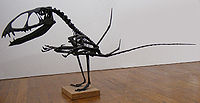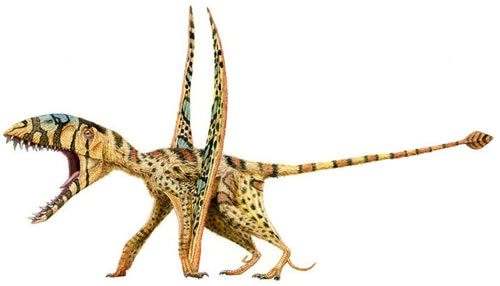Dimorphodon weintraubi
Homepage > Prehistoric Flying Reptiles - Dimorphodon weintraubi
Dimorphodon, "two-formed tooth" belonged to a genus of midium
sized pterosaur that lived during the Early Jurassic Period about 205
million years ago, in what is today sothern England. Its name was given
by paleontologist Richard Owen in 1859.
 Dimorphodon
measured about 4 feet (1.2 meters) wingspan length. It had a huge head
with deep, wide, toothed jaws resembling the beak of the modern-day puffin.
The head measured appoximately 8.5 inches (22 centimeters) in length.
The weight of the head was reduced by thin bony partitions. The jaws contained
four of five fang-like teeth followed by thirty to fourty tiny, pinted
teeth. Its neck was short and its tail was long with a diamond shaped
flap of skin at the end. Its tail was long and consisted of 30 vertebrae.
The first five were short and flexible, but gradually increased in length
and were stiffened by enlongated vertebral processes.
Dimorphodon
measured about 4 feet (1.2 meters) wingspan length. It had a huge head
with deep, wide, toothed jaws resembling the beak of the modern-day puffin.
The head measured appoximately 8.5 inches (22 centimeters) in length.
The weight of the head was reduced by thin bony partitions. The jaws contained
four of five fang-like teeth followed by thirty to fourty tiny, pinted
teeth. Its neck was short and its tail was long with a diamond shaped
flap of skin at the end. Its tail was long and consisted of 30 vertebrae.
The first five were short and flexible, but gradually increased in length
and were stiffened by enlongated vertebral processes.
Dimorphodon's three fingers on each wing were strong and curved, with sharp claws, possibly for climbing rocks or trees. Like many other pterosaurs, it probably made its home along coasts and shores.
Gait
Dimorphodon had very strong, well developed legs, unlike most other pterosaurs.
It could stand with legs under its body, to walk upright on them. Or it
could lean forward and use the fingers on its wings as front feet. Fossilized
track remains of other pterosaurs show a quadrupedal gait while on enlongated,
clawless, and oriented to the side.
Diet
Dimorphodon was certainly a hunter, probably preying on a variety of victims
such as fish, insects, lizards, worms and other small creatures.
Discovery
The first fossil discoveries were made in England by Mary Anning, at Lyme
Regis in Dorset, UK in 1828.
Dimorphodon weintraubi Paleo Galery
Click on images to see more art from artis!


